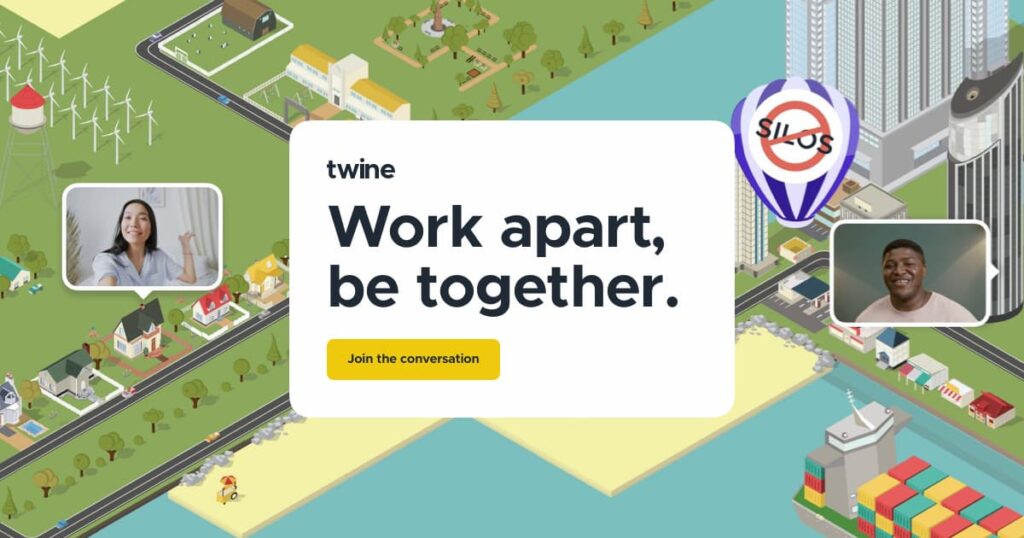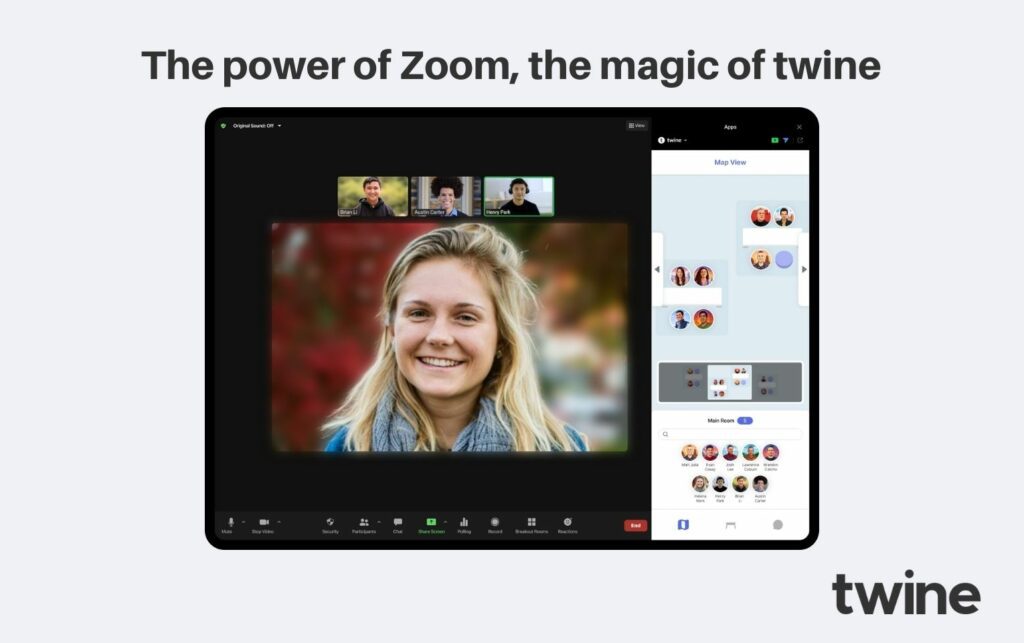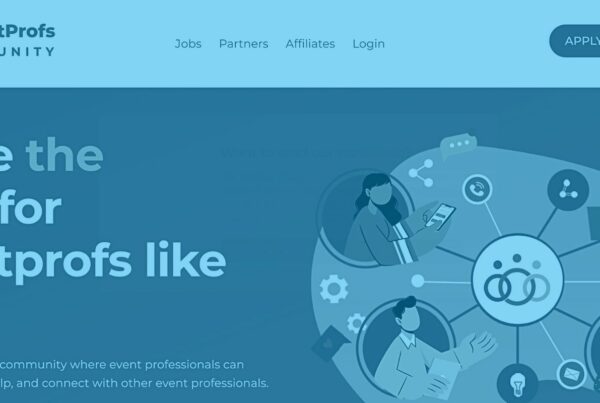The Event Tech Podcast hosts believe that event technology is an amazing foundation for events. Numerous data insights, continuous audience engagement, and endless sponsorship opportunities – what’s not to love? Today, they discuss yet another amazing event technology solution: data-based matchmaking services.
Not only do matchmaking services change the way we can network at virtual events, but they also have immense potential to improve remote company culture and make the most of our internal meetings.
It just so happens that in one of the latest acquisitions in the event technology world, two companies that are all about elevating breakout rooms and providing matchmaking as a service joined forces. We’re talking about twine acquiring Glimpse – a match made in heaven.
Will and Brandt welcome Lawrence Coburn, the co-founder and CEO of twine, and Helena Merk, the co-founder and CEO of Glimpse, to talk about their respective products, the recent acquisition, twine for Zoom, and the metaverse-like future of remote work.
Tune in; match-optimization technology doesn’t only concern event planners, but also everybody interested in making their remote works more connected in organic and dynamic ways.
Introducing twine & Glimpse
Lawrence starts the conversation by explaining what his video chat startup is all about. “twine is a way to recreate the conversations that used to happen in the hallway, the lobby, the elevator, etc. The stuff that you didn’t plan, but made events truly magical. We’re trying to bring that to virtual events and remote teams.”
And Glimpse? “We were building tools to facilitate quick one-on-one video chats where you’d match back-to-back with other people. We focused on how we’re pairing people behind the scenes. Last year, we decided to take a full bet on Zoom, move all of our matchmaking services into a breakout room ecosystem, and be directly integrated there.”
Virtual Matchmaking Services Took Off In The Pandemic
Helena elaborates on how she ended up in the event technology space. Before founding Glimpse, she worked as a software engineer for Smartcar. However, she wanted to work on a project that truly aligned with her core values. Then, her co-founder Luke and she decided to build structured social experiences. “We wanted to guide people through curated one-on-ones, ask deep questions, and unlock interesting forms of conversation.”
Their first prototype was called Gravitate and they were using psychometric analysis to pair people together. “It was hard, but it got us to Y Combinator. We went from being two technical founders to understanding business a little bit.”
As they were taking off in San Francisco, the pandemic hit. With in-person meetings gone, Helena now had an amazing opportunity to scale her business. “Once we moved into video, we connected global communities. We launched on various Facebook groups and exploded in usage overnight.”
Lawrence adds that twine had a similar trajectory as Glimpse. “At twine, we came to the identical assumption that this was never gonna scale. And then the pandemic opened up a limitless opportunity where suddenly you couldn’t meet people in your neighborhood anymore, but you could meet them anywhere in the world. It was a game-changing moment.”

Source: twine
Matchmaking Services Are Based On Data Insights
Will wants to know how an attendee experiences twine as a matchmaking service. “Are they coming into Zoom first? Are Zoom and twine separate products?”
“Portability of core matchmaking expertise is key for twine. We want to go where the events are happening and where the work is getting done. And obviously, Zoom is a monster player. We’ve been building out this web-first platform, which is great. There are a lot of companies in the world that don’t use Zoom. Microsoft is a big customer of ours and we want to build on Microsoft Teams next.”
“Then, we hub-and-spoke it. We’re pulling back data and insights into our core analytics platform. So if you’re a big corporate event producer, we want to be able to give you data insights across the whole spectrum of your whole program about what’s happening and how to make them better. Who’s meeting with who? How many minutes of engagement are happening? Who are your culture carriers within your company that maybe aren’t managers?”
twine’s Focus On Internal Events
“Because of the pandemic, the definition of an event has become blurry. Is my virtual team meeting an event? We have to choose a lane and it’s probably going to be internal events. They are persistent, weekly, recurring use cases: company socials, virtual water coolers.”
Helena adds another exciting feature of twine’s matchmaking as a service. “You can build an entire graph of who inside of an organization knows each other. And if you have recurring events or meetups, you can create an exciting interaction pattern.”
Will loves the idea of using matchmaking services within a remote company. “I’d rather be in a company that is paying for this service than that data getting used for advertisers, as is the case with most social networks. The more data that you have, the better you will match people together. Then, I’ll be less likely to switch services. I’d rather just stick with one single service for a long time because it has all the information on my employees already.”
The Challenges Of Remote Work
Lawrence mentions the challenges some companies faced when switching to remote work. “Research on 60,000 Microsoft employees shows that the networks within Microsoft started withering with remote work. People are not talking to other people outside of their teams. That has a dangerous effect on fast-moving industries. Suddenly, you don’t know the context of what you’re working on and how your work fits into the larger picture.”
And this is where twine comes to the rescue. “It helps you know and care about the people you’re working with. Not only is that good for you as a human, but it’s also good for high-performing teams.”
The Golden Age Of Internal Meetings
Will wants to know what the future holds. “You can apply twine to internal meetings and getting teams unsiloed from each other. How can technology help?”
“Virtual is extremely powerful,” says Helena. “If you ever try to run a speed dating event in person, people don’t move and don’t listen to instructions. But if you have people on the browser or in a Zoom app, and you just switch who they’re talking to and throw them in there, it’s pretty exciting. When we were onboarding people for the first time, people would be shocked. But then they come out of it completely rejuvenated and they want to do it all over again. The matchmaking service also comes with crutches, such as icebreaker questions.”
“So a lot of people, when they’re thinking about the virtual world and event technology, we’re trying to recreate the offline online. But that’s a box that’s limiting people. Why are we trying to recreate offline? Offline wasn’t that great. We can do so much more online,” she adds.
What Lawrence wants event professionals to understand is that this is the golden age of internal meetings. “Face-to-face, digital – doesn’t matter. Companies need this cohesiveness. Internal meetings are just as important as your sales kickoff call or your marketing on events. They have to happen now or you’re going to start to lose connective tissue.”

Source: twine
Matchmaking Services In A Zoom Metaverse
Lawrence asks Helena to say more about the Zoom metaverse and how it could affect the meeting industry. “Tell them about the immersive, early spacial efforts you made inside of Zoom.”
“twine for Zoom will power everything around breakout rooms, but the next stage is a Zoom metaverse. What that means is this Zoom room that never closes. You walk around a virtual world, but it doesn’t feel like what Zoom currently feels like. It’s a map where you can walk and go into your conference rooms. You can also see who’s in which room,” she explains.
Helena adds that this also works for large conferences. “If you have a large multi-day conference, it means never closing the Zoom session. You don’t have to send people a bunch of different registration links. You could have a large stage, one link out to a webinar, or a quiet room where everyone has their videos off.”
Matchmaking Services: Send Tasks & Activities
“Another canvas we’re excited about is templates and activities,” says Lawrence. “A really good way to meet somebody is to not only have a conversation with them but do something together, such as playing a game or problem-solving together. We think each of these breakout tables and rooms is a canvas for us to explore. Easy, automated activities that people can do together.”
Helena adds that hosts will better facilitate what goes on in breakout rooms. “Not only can hosts send tasks, but they can also monitor what is going on in the room. “Currently, you send them away and you don’t know what people are talking about. You don’t know where you can pop in. If they’re talking about something personal, then you’ve ruined it. If they’re not talking about anything, they’re probably not going to tell you.”
“As a host, you can get immediate feedback about tasks checking off, who’s the dominant speaker, and whether the room is silent. We can even expose audio and video streams. The point is that we could build better host management tools.”
Conclusive Thoughts
Lawrence concludes the conversation about matchmaking services and the potential of match-optimization technology for internal meetings by saying that the term ‘breakout rooms’ is too limiting. “If you start to string breakout rooms together, you can start to create a world, a venue that is all tied into your meeting format. The meeting just becomes a little window to start an experience.”
The world is waking up to what we’ve been saying for quite a while at the Event Tech Podcast. Virtual platforms are the new venues, data insights will revolutionize how we approach event strategy, and remote work is here to stay. Tune in for more awesome content soon!










